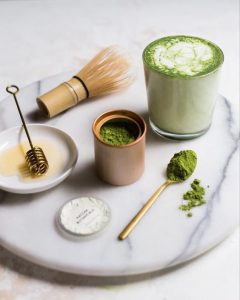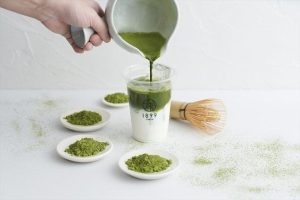What does Matcha Taste Like
Matcha is a tea that is a lot like a cup of coffee, but it’s got more of a mellow, earthy taste. It’s very bitter in the beginning, but after it settles down, the bitterness fades and you get a smooth, sweet finish. It has an earthy flavour and grassy aroma, but no bitterness compared to black or oolong teas.
What is Matcha?
Definition
Matcha, derived from the Japanese words “ma” (ground) and “cha” (tea), translates to “powdered tea.” It is a form of green tea that has been shade-grown, harvested, and stone-ground into a fine powder. Read about What is the Ice Hack Diet
Origin
Matcha originated in China during the Tang Dynasty (618-907 CE) and was later adopted and refined by the Japanese. It became an integral part of Japanese tea ceremonies and Zen Buddhism.
How is Matcha Made?

Cultivation
Matcha is produced from tea plants that are grown under shade for several weeks before harvest. This shading process enhances the chlorophyll content and amino acid production in the leaves, contributing to matcha’s vibrant color and unique flavor.
Processing
After harvest, the leaves are steamed to prevent oxidation, then dried and deveined before being stone-ground into a fine powder. This meticulous process ensures the preservation of flavor and nutrients. Discover about Is Pizza or Wings Healthier
The Flavor Profile of Matcha
Matcha offers a complex flavor profile that sets it apart from other teas. It is characterized by a harmonious balance of sweetness, bitterness, and umami.
Sweetness
High-quality matcha exhibits a natural sweetness, often described as vegetal or grassy, reminiscent of freshly cut grass or steamed greens.
Bitterness
Matcha can also possess a slight bitterness, which adds depth and complexity to its flavor profile. This bitterness is more pronounced in lower grades of matcha.
Umami
One of the most distinctive qualities of matcha is its umami flavor, often described as savory or brothy. This rich and satisfying taste is a result of the amino acid L-theanine, which is abundant in shaded tea leaves.
Factors Influencing Matcha’s Taste
The taste of matcha can vary significantly depending on several factors, including the grade of matcha, growing conditions, and processing techniques.
Grade of Matcha
Matcha is available in various grades, ranging from ceremonial grade, which is the highest quality and most expensive, to culinary grade, which is more affordable and suitable for cooking and baking.
Growing Conditions
The environment in which the tea plants are grown, including soil composition, altitude, and climate, can influence the flavor and aroma of matcha.
Processing Techniques
The methods used to cultivate, harvest, and process the tea leaves play a crucial role in determining the final taste of matcha. Traditional stone-grinding preserves the integrity of the leaves and results in a smoother, more flavorful powder.
Comparing Matcha to Other Teas
While matcha shares similarities with other types of green tea, such as sencha and gyokuro, it also has distinct differences in taste and texture.
Green Tea
Unlike traditional green teas, which are steeped in hot water and discarded after brewing, matcha is consumed in its entirety, allowing for a more intense and concentrated flavor experience.
Black Tea
Compared to black tea, which is fully oxidized and often exhibits bold and robust flavors, matcha offers a smoother, more delicate taste profile with a focus on freshness and vibrancy.
Common Misconceptions about Matcha’s Taste

There are several misconceptions surrounding the taste of matcha, including the belief that it is overwhelmingly bitter or grassy. In reality, high-quality matcha offers a balanced and nuanced flavor that can be enjoyed on its own or incorporated into various recipes.
Personal Experiences and Subjectivity
Taste perception is highly subjective, and individuals may experience matcha differently based on their palate preferences and sensory perceptions. Experimenting with different grades and preparation methods can help uncover the nuances of matcha’s flavor.
How to Prepare Matcha
To fully appreciate the taste of matcha, it’s essential to prepare it correctly. Traditional Japanese tea ceremonies often involve a ceremonial whisk and bowl, but matcha can also be prepared using a simple whisk or electric frother.
Enhancing Matcha’s Flavor
There are several ways to enhance the flavor of matcha, including adding sweeteners like honey or agave syrup, incorporating milk or alternative milk substitutes for a creamy texture, or infusing matcha with other flavors like vanilla or citrus.
Culinary Uses of Matcha
In addition to being enjoyed as a beverage, matcha is a versatile ingredient in culinary applications. It can be used to flavor desserts, baked goods, smoothies, and savory dishes, adding a vibrant green hue and unique taste.
Health Benefits of Matcha
Beyond its delicious taste, matcha is packed with antioxidants, vitamins, and minerals that offer numerous health benefits. It contains catechins, which have been linked to improved heart health, enhanced metabolism, and reduced risk of chronic diseases.
Cultural Significance of Matcha
Matcha holds significant cultural importance in Japan, where it is celebrated as a symbol of hospitality, mindfulness, and tranquility. It continues to play a central role in traditional tea ceremonies and has become a cherished part of Japanese culinary heritage.
Conclusion
In conclusion, the taste of matcha is a delightful blend of sweetness, bitterness, and umami, with nuances that vary depending on factors such as grade, growing conditions, and processing techniques. Whether enjoyed as a comforting cup of tea or incorporated into culinary creations, matcha offers a unique and satisfying flavor experience that captivates the senses.
FAQs
- Is matcha sweeter than regular green tea?
- While matcha does have a natural sweetness, it can vary depending on the grade and preparation method. Some people may find it sweeter than traditional green tea, while others may notice more bitterness or umami.
- Can I mix matcha with milk?
- Yes, matcha can be mixed with milk or alternative milk substitutes to create a creamy and indulgent beverage known as a matcha latte. This is a popular way to enjoy matcha, particularly in Western countries.
- Is matcha healthy?
- Yes, matcha is renowned for its health benefits due to its high antioxidant content. It can support heart health, boost metabolism, and provide a natural energy boost without the crash associated with caffeine.
- How do I choose the best matcha?
- Look for matcha that is vibrant green in color, finely ground, and has a fresh aroma. Ceremonial grade matcha is typically the highest quality and offers the best flavor profile for drinking, while culinary grade matcha is suitable for cooking and baking.
- Can matcha be bitter?
- Yes, matcha can have a slight bitterness, especially in lower grades. However, this bitterness is often balanced by sweetness and umami, creating a harmonious flavor profile that is enjoyable to many.
